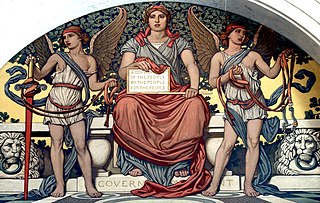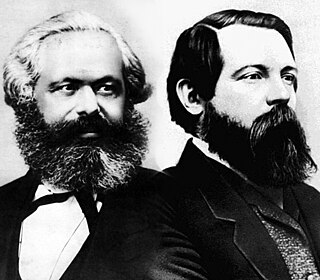
In commerce, supply chain management (SCM), the management of the flow of goods and services, between businesses and locations, and includes the movement and storage of raw materials, of work-in-process inventory, and of finished goods as well as end to end order fulfillment from point of origin to point of consumption. Interconnected, interrelated or interlinked networks, channels and node businesses combine in the provision of products and services required by end customers in a supply chain.

Physiocracy is an economic theory developed by a group of 18th-century Age of Enlightenment French economists who believed that the wealth of nations derived solely from the value of "land agriculture" or "land development" and that agricultural products should be highly priced. Their theories originated in France and were most popular during the second half of the 18th century. Physiocracy became one of the first well-developed theories of economics.
A variety of measures of national income and output are used in economics to estimate total economic activity in a country or region, including gross domestic product (GDP), gross national product (GNP), net national income (NNI), and adjusted national income. All are specially concerned with counting the total amount of goods and services produced within the economy and by various sectors. The boundary is usually defined by geography or citizenship, and it is also defined as the total income of the nation and also restrict the goods and services that are counted. For instance, some measures count only goods & services that are exchanged for money, excluding bartered goods, while other measures may attempt to include bartered goods by imputing monetary values to them.

A price is the quantity of payment or compensation given by one party to another in return for one unit of goods or services. In some situation, the price of production has a different name. If the product is a "good" in the commercial exchange, the price of this product will likely to be called "price". However, if the product is "service", there will be other possible names for this product's name. For example, the graph on the bottom will show some situations A price is influenced by production costs, supply of the desired item, and demand for the product. A price may be determined by a monopolist or may be imposed on the firm by market conditions.

Distribution is one of the four elements of the marketing mix. Distribution is the process of making a product or service available for the consumer or business user who needs it. This can be done directly by the producer or service provider, or using indirect channels with distributors or intermediaries. The other three elements of the marketing mix are product, pricing, and promotion.

Service economy can refer to one or both of two recent economic developments:
A value chain is a set of activities that a firm operating in a specific industry performs in order to deliver a valuable product for the market. The concept comes through business management and was first described by Michael Porter in his 1985 best-seller, Competitive Advantage: Creating and Sustaining Superior Performance.
The idea of the value chain is based on the process view of organizations, the idea of seeing a manufacturing organization as a system, made up of subsystems each with inputs, transformation processes and outputs. Inputs, transformation processes, and outputs involve the acquisition and consumption of resources – money, labour, materials, equipment, buildings, land, administration and management. How value chain activities are carried out determines costs and affects profits.
An ad valorem tax is a tax whose amount is based on the value of a transaction or of property. It is typically imposed at the time of a transaction, as in the case of a sales tax or value-added tax (VAT). An ad valorem tax may also be imposed annually, as in the case of a real or personal property tax, or in connection with another significant event. In some countries a stamp duty is imposed as an ad valorem tax.
In business, total value added is calculated by tabulating the unit value added per each unit of product sold. Thus, total value added is equivalent to revenue minus intermediate consumption. Value added is a higher portion of revenue for integrated companies and a lower portion of revenue for less integrated companies ; total value added is very closely approximated by compensation of employees, which represents a return to labor, plus earnings before taxes, representative of a return to capital.

An indirect tax is a tax that is levied upon goods and services before they reach the customer who ultimately pays the indirect tax as a part of market price of the good or service purchased. Alternatively, if the entity who pays taxes to the tax collecting authority does not suffer a corresponding reduction in income, i.e., impact and tax incidence are not on the same entity meaning that tax can be shifted or passed on, then the tax is indirect.

Tax revenue is the income that is gained by governments through taxation. Taxation is the primary source of government revenue. Revenue may be extracted from sources such as individuals, public enterprises, trade, royalties on natural resources and/or foreign aid. An inefficient collection of taxes is greater in countries characterized by poverty, a large agricultural sector and large amounts of foreign aid.

Surplus product is an economic concept explicitly theorised by Karl Marx in his critique of political economy. Marx first began to work out his idea of surplus product in his 1844 notes on James Mill's Elements of political economy.

A market is a composition of systems, institutions, procedures, social relations or infrastructures whereby parties engage in exchange. While parties may exchange goods and services by barter, most markets rely on sellers offering their goods or services to buyers in exchange for money. It can be said that a market is the process by which the prices of goods and services are established. Markets facilitate trade and enable the distribution and resource allocation in a society. Markets allow any trade-able item to be evaluated and priced. A market emerges more or less spontaneously or may be constructed deliberately by human interaction in order to enable the exchange of rights of services and goods. Markets generally supplant gift economies and are often held in place through rules and customs, such as a booth fee, competitive pricing, and source of goods for sale.

An import in the receiving country is an export from the sending country. Importation and exportation are the defining financial transactions of international trade.
New business development concerns all the activities involved in realizing new business opportunities, including product or service design, business model design, and marketing. When splitting business development into two parts, we have: ‘business’ and ‘development’. The first things that come into mind when looking at business are: economics, finance, managerial activities, competition, prices, marketing, etc. All of these keywords are related to risk and entrepreneurship and clearly indicate the primary scope of the term ‘business development’. Development is very abstract and can be linked with some of the following keywords: technological improvement, cost reduction, general welfare, improved relations, movement in a (positive) direction, etc.
The following outline is provided as an overview of and topical guide to production:
A customer benefit package (CBP) forms part of the operations management (OM) toolkit. It involves a clearly defined set of tangible (goods) and intangible (services) features that the customer recognizes, purchase or use. This can be the real or perceived value that a customer experiences or believes they are receiving through dealing with a company.
The concepts of a global value chain (GVC) and global supply chain refer to the people, roles and activities involved in the production of goods and services and their supply, distribution, and post-sales activities when those activities must be coordinated across geographies. GVC is similar to Industry Level Value Chain but encompasses operations at the global level.
The agricultural value chain concept has been used since the beginning of the millennium, primarily by those working in agricultural development in developing countries. Although there is no universally accepted definition of the term, it normally refers to the whole range of goods and services necessary for an agricultural product to move from the farm to the final customer or consumer.

A value-added tax (VAT), known in some countries as a goods and services tax (GST), is a type of tax that is assessed incrementally. It is levied on the price of a product or service at each stage of production, distribution, or sale to the end consumer. If the ultimate consumer is a business that collects and pays to the government VAT on its products or services, it can reclaim the tax paid. It is similar to, and is often compared with, a sales tax.










